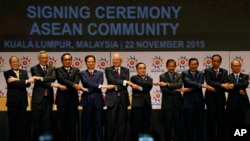Efforts to integrate Southeast Asia’s economies are beginning to bear fruit, experts say, although there is some way to go before the goal of turning the region into a single market and production base can be reached.
The 10 countries of the Association of Southeast Asian Nations officially formed the ASEAN Economic Community (AEC), an ambitious regional trade bloc, at the start of this year.
The move has been viewed as a boost for the region’s economies and is part of the reasoning behind the U.S. stepping up its engagement with the region. Leaders of the 10 ASEAN nations will attend a summit hosted by President Barack Obama at the Sunnylands estate in Rancho Mirage, California on Monday and Tuesday, followed by a trade roadshow in the San Francisco Bay Area.
The ASEAN countries already have a combined annual gross domestic product of $2.4 trillion, making the bloc the second largest economy in Asia, after China, and the seventh-largest economy in the world. The region also enjoys an average growth rate in excess of 5 percent.
“ASEAN has so much potential to offer for international investment and trade because of its young population,” said Chan Sophal, director of the Center for Policy Studies in Phnom Penh. “That plays a key role to creating a competitive workforce, and that is what investors are looking for.”
Chheang Vannarith, chairman of the Cambodian Institute for Strategic Studies’ board of directors, has noted that the region will soon also be better connected thanks largely to Chinese plans to build railways connecting the countries of mainland Southeast Asia to Yunnan province.
“We also see Thailand and Cambodia created a railroad project which they hope to complete by the end of 2016,” Vannarith said.
But there are concerns that turning the region into an integrated market and production base is still some way off. Anthony Nelson, director of communications at the U.S.-ASEAN Business Council, told a recent press conference in Washington that while the AEC was an “exciting” initiative, some of its goals were ambitious.
“If you look at the customs single window…in order for ASEAN to really, truly be a single market and a single production base, that’s something that’s going to be in place,” Nelson said.
The U.S.-ASEAN Business Council has also raised the issues of corruption and poor governance as barriers to trade with Southeast Asian economies.
Oum Sothea, a Cambodian economist based in Singapore, said that most tariffs imposed on goods imported within the region had already been reduced to zero, with very few exceptions. However, he said, there were a number of “non-tariff” barriers to trade still in place that would require the states’ concerted collective action to remove.
“ASEAN countries implement different set of rules for product standardization, and having to harmonize such a diverse set of rules is going to be the biggest challenge for ASEAN to achieve a single production base,” said Oum Sothea.
For the U.S., the ASEAN countries as a bloc are already the country’s fourth-largest trading partner. By 2014, American companies had put more than $200 million of foreign direct investment in to the region.
At a recent public forum, Ben J. Rhodes, Obama’s deputy national security adviser for strategic communications, reiterated ASEAN’s importance to U.S. economic growth.
“The fact that matters is this region is going to drive a lot of U.S. growth and job creation going forward that already support, in our estimate, over half a million American jobs,” said Rhodes, predicting that ASEAN was soon going to be one of the largest markets in the world for U.S. exports.








